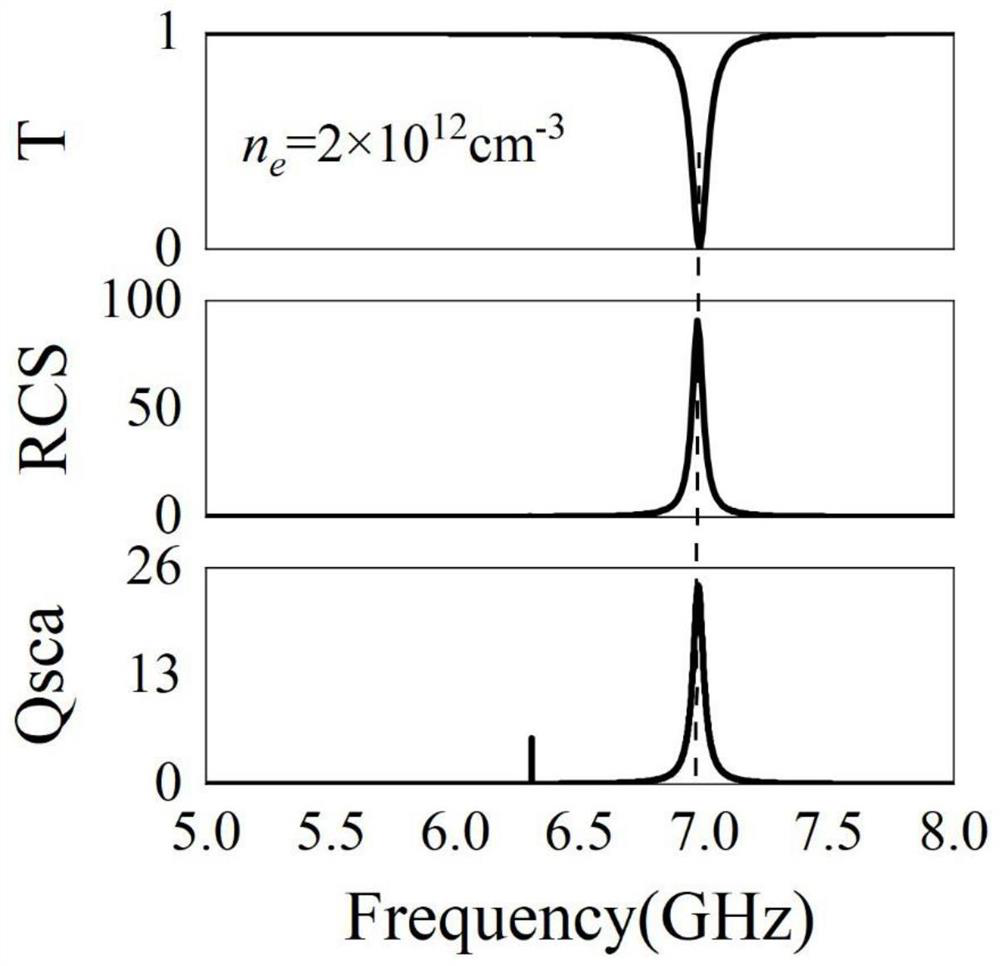Tunable optical switch based on array plasma columns
A plasma and plasma technology, applied in the field of tunable optical switches, can solve the problems of small adjustable degree of freedom and uncontrollable Fano resonance frequency
- Summary
- Abstract
- Description
- Claims
- Application Information
AI Technical Summary
Problems solved by technology
Method used
Image
Examples
Embodiment 1
[0023] This embodiment provides a tunable optical switch based on an array of plasmonic columns, such as figure 1 , including: a metasurface with a thickness smaller than the working wavelength, the metasurface has a regular geometric shape, and there are at least three plasmonic columns distributed in parallel and equally spaced within the metasurface;
[0024] Using the Mie scattering theory to obtain the Mie scattering coefficient of a single plasma column, so that the Mie scattering of a single plasma column interferes with the Bragg scattering produced by the array plasma column to produce the Fano resonance phenomenon;
[0025] The metasurface is made of clad quartz tubes and plasma columns.
[0026] Specifically, the metasurface is rectangular, and the geometric parameters of all plasmonic columns are exactly the same.
[0027] Specifically, the geometric parameters of the metasurface, the radius of the quartz tube r 1 =1.0mm plasma radius r 1 = 0.66mm metasurface pe...
Embodiment 2
[0041] Present embodiment is on the basis of implementation 1, establishes parameter as d=3.9mm, r 1 =1.0mm, r 2 =0.66mm,n e =2.0×10 12 cm -3 At the same time, use the simulation software based on the finite element method to perform numerical and analytical calculations for the period p, and the results are as follows Figure 5 , is the relationship between transmission coefficient and frequency when the parameter p changes.
[0042] Figure 5 It shows that when 10.0mm<p<12.0mm, the Fano resonance line spectrum has a slight blue shift and the line width narrows; when 12.0mm<p<30.0mm, the Fano resonance frequency remains basically unchanged.
Embodiment 3
[0044] This embodiment is on the basis of embodiment 1, establishes parameter p=18.0mm, r 1 =1.0mm, r 2 =0.66mm,n e =2.0×10 12 cm -3 At the same time, the simulation software based on finite element method is used for numerical and analytical calculation of d, and the results are as follows Figure 6 , is the relationship between transmission coefficient and frequency when the parameters are changed.
[0045] Figure 6 It shows that with the increase of d, the resonance frequency red shifts, but the red shift trend at 2.0mm<d<6.0mm is more obvious than that at 6.0mm<d<8.0mm.
[0046] It can be seen from the above embodiments that the resonant frequency of the Fano resonance can be tuned by changing the geometric parameters, but the tuning frequency range is far less convenient than that obtained by changing the plasma density.
PUM
| Property | Measurement | Unit |
|---|---|---|
| Radius | aaaaa | aaaaa |
Abstract
Description
Claims
Application Information
 Login to View More
Login to View More - R&D
- Intellectual Property
- Life Sciences
- Materials
- Tech Scout
- Unparalleled Data Quality
- Higher Quality Content
- 60% Fewer Hallucinations
Browse by: Latest US Patents, China's latest patents, Technical Efficacy Thesaurus, Application Domain, Technology Topic, Popular Technical Reports.
© 2025 PatSnap. All rights reserved.Legal|Privacy policy|Modern Slavery Act Transparency Statement|Sitemap|About US| Contact US: help@patsnap.com



